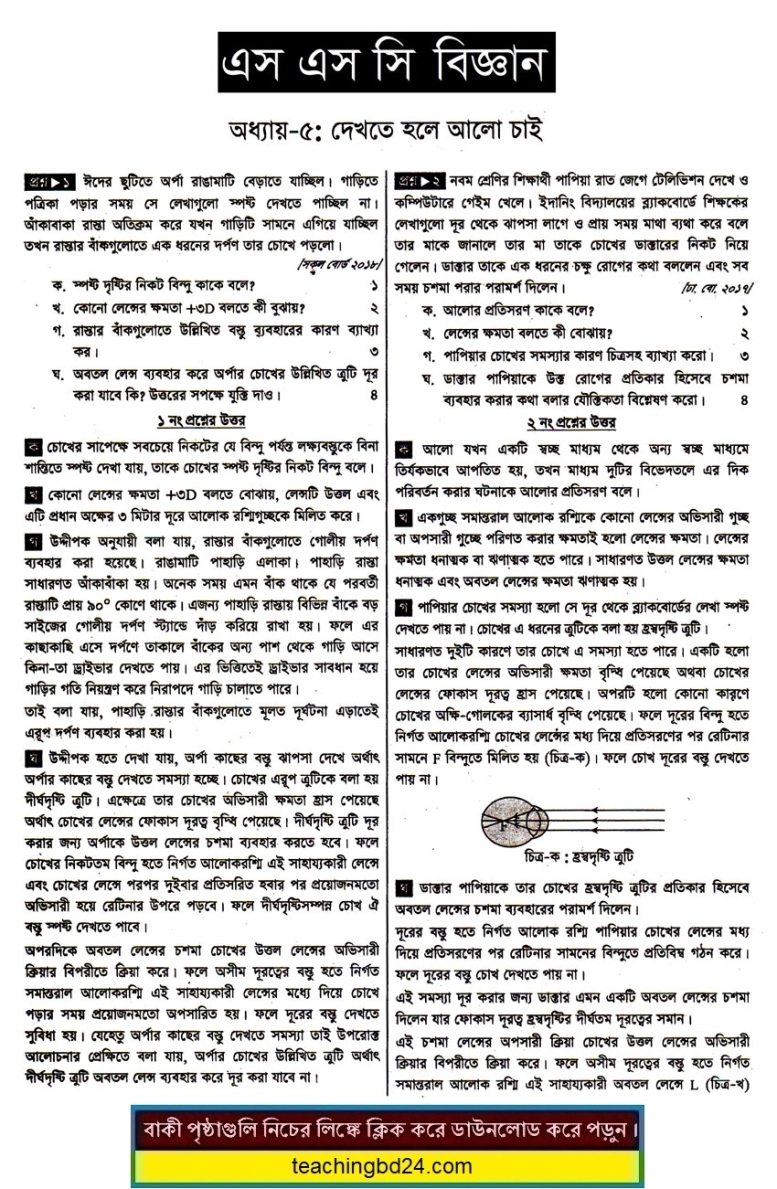Chapter 5. Light for Sight. The necessity of light is unlimited in our daily life. If we close our eyes we cannot see anything. Again in a completely dark place, we cannot see anything in spite of opening our eyes. Light is that cause, with the help of which we can see.
You have been acquainted with the different phenomena of light at the junior secondary level. In this chapter, other than the uses of mirrors, you will know more about the refraction of light. Moreover, you will know about the functions of eyes, the least distance of distinct vision, the power of the lens, a defect of vision and uses of the lens and the way of keeping eyes normal.
Chapter 5. Light for Sight

You have seen the refraction of light and its real application in class eight. We know that in a transparent homogeneous medium-light always travels in a straight line. When a ray of the light incident not perpendicularly but obliquely from one transparent medium to another transparent medium the direction of the ray changes at the surface of separation of the two media. The phenomenon of this change in direction of a ray is called the refraction of light.

Keratoconus is the leading cause of severe visual impairment in children and adolescents worldwide. The disease often remains undetected for a long time and can lead to blindness at a later stage. Children and adolescents are at the greatest risk, as the disease is the most aggressive in these age groups
Children and adolescents with Down syndrome (trisomy 21) are at a high risk of developing keratoconus
Before the advent of cross-linking technology, the only treatment option was corneal transplantation. However, this is a particular risk especially in people with Down’s syndrome, as many sufferers very often rub their eyes, which can lead to bleeding of the sutures of the graft and a loss of the cornea and the eye
The best way to treat this condition in people with Down syndrome is early detection. The aim of the initiative is to provide all ophthalmologists with cross-linking information about the disease and the treatment options, as well as to encourage parents to have their children, especially children with Down syndrome, undergo an examination. Last but not least, all other medical professionals involved in the care of people with Down Syndrome, such as general practitioners and pediatricians, must also be informed.
The eye is our collector of light, giving us sight. Its delicate structures enable entering light energy to be converted to electrochemical energy. This stimulates the visual centers in the brain, giving us the sensation of seeing. Sight is one of five human senses that act as ‘gatekeepers’ of our bodies.
Dr. Adrian Dorrington from the University of Waikato is investigating time-of-flight 3D cameras. The problem to be resolved in Adrian’s research is how to improve the capability of these cameras to measure accurately distance from the camera to the object being viewed.
Associate Professor Rainer Künnemeyer is also from the University of Waikato, but his area of research is in biophotonics. This is a branch of science that deals with the interaction of light with biological materials. Part of Rainer’s research involves developing a laser light scattering method to assess the ripeness of different fruits.
teachingbd24.com is such a website where you would get all kinds of necessary information regarding educational notes, suggestions and questions’ patterns of school, college, and madrasahs. Particularly you will get here special notes of physics that will be immensely useful to both students and teachers. The builder of the website is Mr. Md. Shah Jamal Who has been serving for 30 years as an Asst. Professor of BAF Shaheen College. He expects that this website will meet up all the needs of Bengali version learners /students. He has requested concerned both students and teachers to spread this website home and abroad.
Discover more from Teaching BD
Subscribe to get the latest posts sent to your email.


